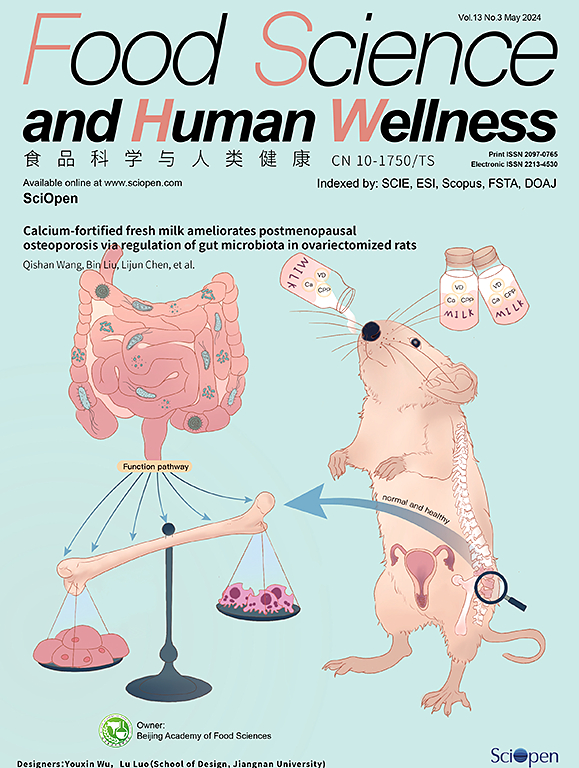亚麻籽木酚素大分子的结构鉴定和抗氧化活性评估:结构-活性相关性
IF 7.4
1区 农林科学
Q1 FOOD SCIENCE & TECHNOLOGY
引用次数: 0
摘要
亚麻籽木脂素大分子(FLM)是亚麻籽中一类重要的次生代谢产物,因其生物学和药理学特性,尤其是抗氧化活性而受到广泛关注。对于FLM的组成和结构,我们的结果证实阿魏酸糖苷(FerAG)与草杆菌素二糖苷(HDG)或松脂醇二糖苷(PDG)直接酯连接,这可能决定了FLM生物合成的开始。此外,对香豆酸苷(coumaric acid glycoside, coag)可能决定了亚麻籽FLM合成过程中链延伸的末端。FLM在极性体系中具有较强的1,1-二苯基-2-吡啶酰肼(DPPH)自由基清除能力,而在非极性体系中具有较强的2,2'-氮唑(3-乙基苯并噻唑-6-磺酸)(ABTS)阳离子自由基清除能力。此外,发现FLM的抗氧化活性高度依赖于其组成和结构。特别是,它与酚羟基的数量(较长的FLM链)正相关,与末端的空间位阻(较低水平的FerAG和CouAG)负相关。这些发现证实了FLM在非极性体系中的潜在应用,特别是在功能性食品乳剂中的应用。本文章由计算机程序翻译,如有差异,请以英文原文为准。

Structural identification and antioxidative activity evaluation of flaxseed lignan macromolecules: structure-activity correlation
Flaxseed lignan macromolecules (FLM) are a class of important secondary metabolites in flaxseed, which have been widely concerned due to their biological and pharmacological properties, especially for their antioxidative activity. For the composition and structure of FLM, our results confirmed that ferulic acid glycoside (FerAG) was directly ester-linked with herbacetin diglucoside (HDG) or pinoresinol diglucoside (PDG), which might determine the beginning of FLM biosynthesis. Additionally, p-coumaric acid glycoside (CouAG) might determine the end of chain extension during FLM synthesis in flaxseed. FLM exhibited higher antioxidative activity in polar systems, as shown by its superior 1,1-diphenyl-2-picrylhydrazyl (DPPH) free radical scavenging capacity compared to the 2,2'-azinobis(3-ehtylbenzothiazolin-6-sulfnic acid) (ABTS) cation free radical scavenging capacity in non-polar systems. Moreover, the antioxidative activity of FLM was found to be highly dependent on its composition and structure. In particular, it was positively correlated with the number of phenolic hydroxyl groups (longer FLM chains) and inversely related to the steric hindrance at the ends (lower levels of FerAG and CouAG). These findings verified the potential application of FLM in non-polar systems, particularly in functional food emulsions.
求助全文
通过发布文献求助,成功后即可免费获取论文全文。
去求助
来源期刊

Food Science and Human Wellness
Agricultural and Biological Sciences-Food Science
CiteScore
8.30
自引率
5.70%
发文量
80
审稿时长
28 days
期刊介绍:
Food Science and Human Wellness is an international peer-reviewed journal that provides a forum for the dissemination of the latest scientific results in food science, nutriology, immunology and cross-field research. Articles must present information that is novel, has high impact and interest, and is of high scientific quality. By their effort, it has been developed to promote the public awareness on diet, advocate healthy diet, reduce the harm caused by unreasonable dietary habit, and directs healthy food development for food industrial producers.
 求助内容:
求助内容: 应助结果提醒方式:
应助结果提醒方式:


